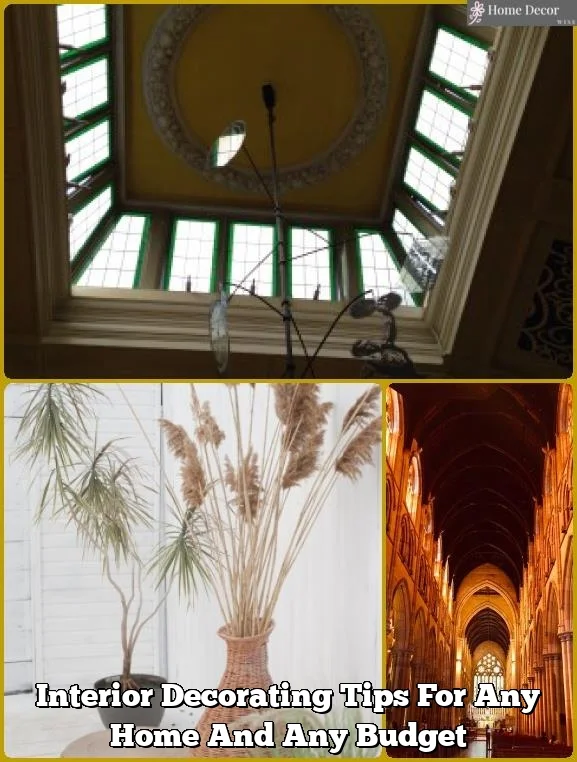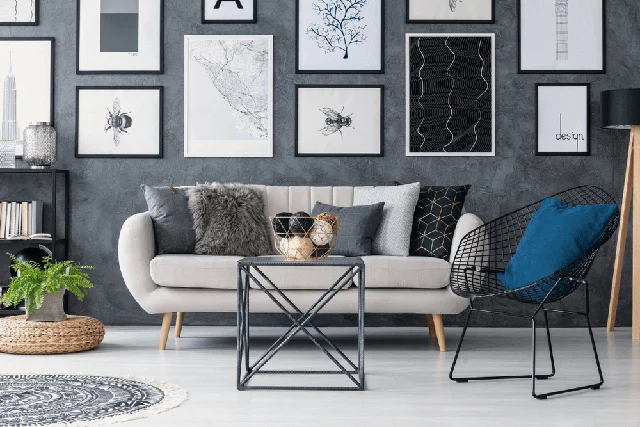Are you wondering how to budget for home decorating? Creating a budget for decorating your home is an important step in achieving the look and feel you want while staying within your financial means. In this article, we will explore the importance of budgeting for home decorating and provide practical tips on how to effectively manage your finances while beautifying your living space.
When it comes to home decorating, having a clear understanding of your current financial situation is crucial. Assessing your income, expenses, savings, and any existing debt will help you determine how much you can comfortably allocate towards decorating your home. By setting realistic budget goals based on your financial assessment, you can avoid overspending and make informed decisions about where to allocate your decorating funds.
In addition to setting realistic budget goals, it’s important to prioritize your decorating needs versus wants. Identifying essential purchases versus optional items will help you stay focused on what truly matters as you allocate your decorating budget.
Further research into decor styles and their associated costs will also help ensure that you make informed decisions that align with both your personal taste and financial constraints. Stay tuned as we delve into these topics in more detail throughout the rest of this article.
Assessing Your Current Financial Situation
Before embarking on any home decorating project, it is crucial to assess your current financial situation. This will help you determine how much you can realistically afford to spend on decor and prioritize your decorating needs. Here are some steps to take when assessing your current financial situation:
1. Take stock of your monthly income and expenses: Start by creating a detailed list of all your monthly income sources and expenses. This will give you a clear picture of how much disposable income you have available for home decorating.
2. Review your savings and emergency fund: It’s important to consider your savings and emergency fund when budgeting for home decor. While it’s tempting to dip into these funds for decorating, it’s essential to prioritize financial security.
3. Consider any outstanding debts or financial commitments: Assessing your current financial situation also involves taking a look at any outstanding debts or financial commitments you may have. This will help you gauge how much extra cash you have available for decorating without compromising other financial goals.
Once you have a clear understanding of your current financial situation, you can move on to setting realistic budget goals for your home decorating project.
By thoroughly assessing your current financial situation and understanding how much disposable income you have available, you’ll be better equipped to set realistic budget goals for your home decorating project.
Setting Realistic Budget Goals
When it comes to home decorating, it’s crucial to set realistic budget goals in order to achieve the desired look for your living space without breaking the bank. One of the key aspects of how to budget for home decorating is assessing your current financial situation and determining how much you can realistically afford to spend on decor.
This involves taking a close look at your income, expenses, and any existing debt to understand what funds are available for decorating.
Once you have a clear understanding of your financial situation, the next step is to set realistic budget goals for your home decorating project. This means determining a specific amount that you are comfortable allocating towards decor and sticking to it. Setting realistic budget goals will help prevent overspending and ensure that you stay within your means while still achieving the aesthetic you desire for your home.
In addition to setting a specific budget amount, it’s also important to establish priorities within your budget. This involves deciding where you want to allocate more of your decorating funds based on what aspects are most important to you. For example, if updating the furniture in your living room is a top priority, then allocating a larger portion of your budget towards this area would be appropriate.
| Assessing Your Current Financial Situation | Setting Realistic Budget Goals |
|---|---|
| Determining available funds for decorating | Establishing specific budget amount |
| Understanding income, expenses, and debt | Setting priorities within budget |
Prioritizing Decorating Needs vs Wants
When it comes to home decorating, it’s important to prioritize your needs over your wants in order to stay within your budget. By distinguishing between the two and focusing on what is essential, you can avoid overspending and make the most of your decorating budget.
Assessing Your Needs
Start by assessing the current state of your home and identifying any areas that are in need of attention. This could include outdated furniture, peeling paint, or a lack of storage space. By pinpointing these specific needs, you can allocate a portion of your budget towards addressing them first.
Evaluating Your Wants
While it’s natural to want to splurge on trendy decor items or luxury furniture pieces, it’s important to be mindful of your overall budget. Evaluate which wants are realistic within your means and consider postponing others for future decorating projects. By prioritizing your needs over wants, you can ensure that the essential aspects of your home are taken care of before indulging in extra adornments.
Staying Flexible
It’s also key to remain flexible with your decorating plans as unexpected expenses may arise. By understanding the difference between needs and wants and staying open to adjustments, you can navigate through the decorating process without breaking the bank.
By prioritizing your decorating needs over wants, you can approach the process with a clear focus on essentials while still adding personal touches within budget constraints. With careful consideration and flexibility, you can achieve a well-decorated home without overspending.
Researching Decor Styles and Cost
When it comes to home decorating, one of the most important steps in budgeting is researching decor styles and their associated costs. This process involves exploring different design aesthetics and assessing the financial implications of each style. By doing so, you can make informed decisions about the direction of your home decor while staying within your budget.
Exploring Different Decor Styles
Before making any decor purchases, take the time to explore various decor styles to find what resonates with you. Whether it’s minimalism, farmhouse chic, bohemian, or mid-century modern, understanding how each style can be achieved within your budget is crucial. Look for inspiration in magazines, on social media platforms like Pinterest and Instagram, and by visiting home decor stores or showrooms.
Assessing Associated Costs
Once you’ve identified the decor styles that appeal to you, it’s essential to assess the associated costs. Certain styles may require more expensive furnishings or decor elements, while others may lend themselves to budget-friendly DIY options.
Take note of the average cost of key items such as furniture, lighting fixtures, curtains, rugs, and decorative accents for each style you’re considering. This will give you a better understanding of how much you’ll need to allocate in your budget for achieving your desired look.
Consideration of Long-Term Maintenance
In addition to upfront costs, consider the long-term maintenance expenses associated with different decor styles. For example, certain materials may require more upkeep and replacement over time than others. By factoring in these ongoing expenses into your budgeting process now, you can avoid unexpected financial strain in the future.
Finding Budget-Friendly Decor and DIY Ideas
Home decorating doesn’t have to break the bank. In fact, with some creativity and resourcefulness, you can achieve a beautifully decorated home on a budget. In this section, we will discuss how to find budget-friendly decor and DIY ideas to bring your vision to life without overspending.
When it comes to finding budget-friendly decor, there are several options to consider. Thrift stores, garage sales, and online marketplaces can be treasure troves for unique and affordable pieces. Additionally, consider repurposing items you already own or borrowing from friends and family to save on costs.
DIY projects also offer a cost-effective way to decorate your home. From creating your own artwork to upcycling furniture, there are endless possibilities for adding personal touches to your space without breaking the bank.
Another valuable resource for budget-friendly decor is the vast world of online DIY tutorials and inspiration. Websites, blogs, and social media platforms offer a wealth of ideas for creating stylish decor on a budget. From simple crafting projects to room makeover tips, these resources can guide you in transforming your space without spending a fortune.
As you explore budget-friendly decor options and DIY ideas, keep in mind that patience and creativity are key. With careful planning and a willingness to think outside the box, you can achieve a beautifully decorated home that reflects your style without exceeding your budget limitations. By taking advantage of secondhand finds, embracing DIY projects, and seeking out affordable inspiration online, you can create a welcoming and stylish home without breaking the bank.
Budgeting Tips for Furniture and Large Purchases
When it comes to home decorating, one of the biggest expenses you will encounter is furniture and other large purchases. It’s important to carefully budget for these items to ensure that you stay on track with your overall decorating budget. Here are some tips on how to budget for furniture and large purchases:
1. Set a clear budget: Before you start shopping for furniture or other big-ticket items, it’s essential to have a clear understanding of how much you can afford to spend. Take into account your overall decorating budget and allocate a specific amount for furniture and large purchases.
2. Research and compare prices: Once you have a budget in mind, do some research to get an idea of the cost of the items you need. Look at different stores and online retailers to compare prices and find the best deals. Don’t forget to factor in delivery or shipping costs if applicable.
3. Consider second-hand or gently used options: If your budget is tight, consider looking for pre-owned furniture or decor items. There are many online marketplaces where you can find high-quality second-hand pieces at a fraction of the cost of new ones.
4. Be open to DIY options: Sometimes, you can save money by taking on simple do-it-yourself projects, such as repainting old furniture or reupholstering chairs. With a little creativity and effort, you can give new life to existing pieces without breaking the bank.
By following these budgeting tips for furniture and large purchases when decorating your home, you can ensure that you stay within your overall decorating budget while still achieving the look and feel that you desire for your living space.
Tracking and Adjusting Your Decorating Budget
When it comes to home decorating, the importance of budgeting cannot be overstated. Without a well-planned budget, decorating your home can quickly become overwhelming and costly. In this section, we will discuss the importance of tracking and adjusting your decorating budget to ensure that you stay on track financially while achieving your desired decor goals.
Once you have set a budget for your home decorating project, it is crucial to track your expenses and regularly assess whether you are staying within your set budget. This involves keeping detailed records of all your spending related to home decor, including small purchases and larger investments such as furniture or appliances. By consistently monitoring your expenses, you can identify any areas where you may be overspending and make necessary adjustments to stay within your budget.
In addition to tracking your spending, it is essential to be flexible and willing to adjust your decorating budget as needed. Unexpected expenses or changes in priorities may arise during the decorating process, making it necessary to reallocate funds from one area to another. By being open to adjusting your budget when necessary, you can ensure that you are making informed financial decisions throughout the decorating process.
By understanding how to budget for home decorating and effectively tracking and adjusting your expenses along the way, you can successfully achieve your desired decor goals while maintaining financial stability. Remember that flexibility and diligence are key when it comes to managing a decorating budget, allowing you to create a beautiful space without breaking the bank.
Conclusion
In conclusion, budgeting for home decorating is an essential step in achieving your desired decor without breaking the bank. By assessing your current financial situation, setting realistic budget goals, and prioritizing decorating needs versus wants, you can create a budget that works for you.
Researching decor styles and costs, finding budget-friendly decor and DIY ideas, as well as utilizing budgeting tips for furniture and large purchases can also help you stick to your budget while still achieving the look you want for your home.
It’s important to remember that budgeting for home decorating is a continuous process. Tracking and adjusting your decorating budget as needed will help you stay on track and avoid overspending. There are always opportunities to find cost-effective solutions for your home decorating needs, and staying flexible with your plans can help ensure that your budget remains manageable.
By following these steps on how to budget for home decorating, you can successfully achieve your home decorating goals within budget. With careful planning and diligent adherence to your financial plan, you can transform your space into a beautiful and inviting sanctuary without sacrificing your financial stability. Remember, with the right approach and mindset, it is possible to create a stylish living space that reflects your personal taste while staying within your means.
Frequently Asked Questions
What Is the 70 30 Rule in Interior Design?
The 70 30 rule in interior design refers to the concept of dividing your space into 70% dominant color, 30% secondary color. This ratio helps create a balanced and cohesive look in a room, ensuring that one color does not overpower the others.
What Is the 2 3 Rule in Decorating?
The 2 3 rule in decorating involves dividing a room’s colors and patterns into two-thirds primary color and one-third accent color or pattern. This guideline helps maintain visual balance while adding interest to the space without overwhelming it with too many contrasting elements.
How Can I Decorate My House on a Budget?
Decorating on a budget can be achieved by prioritizing essential items, such as investing in versatile pieces of furniture that can work in multiple rooms. DIY projects, thrift store finds, and strategic use of paint can also help refresh and personalize your space without breaking the bank.

I’m thrilled to be your companion on this exciting journey through the world of home decor and design. With a passion for turning houses into homes and a keen eye for the finer details, I’m here to help you transform your living spaces into beautiful, functional, and meaningful havens.





